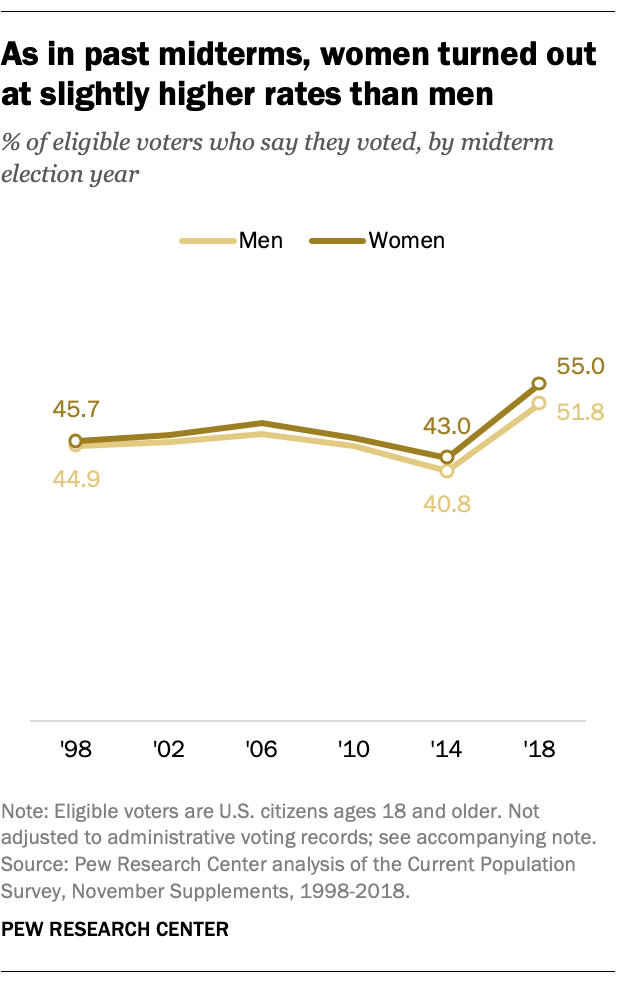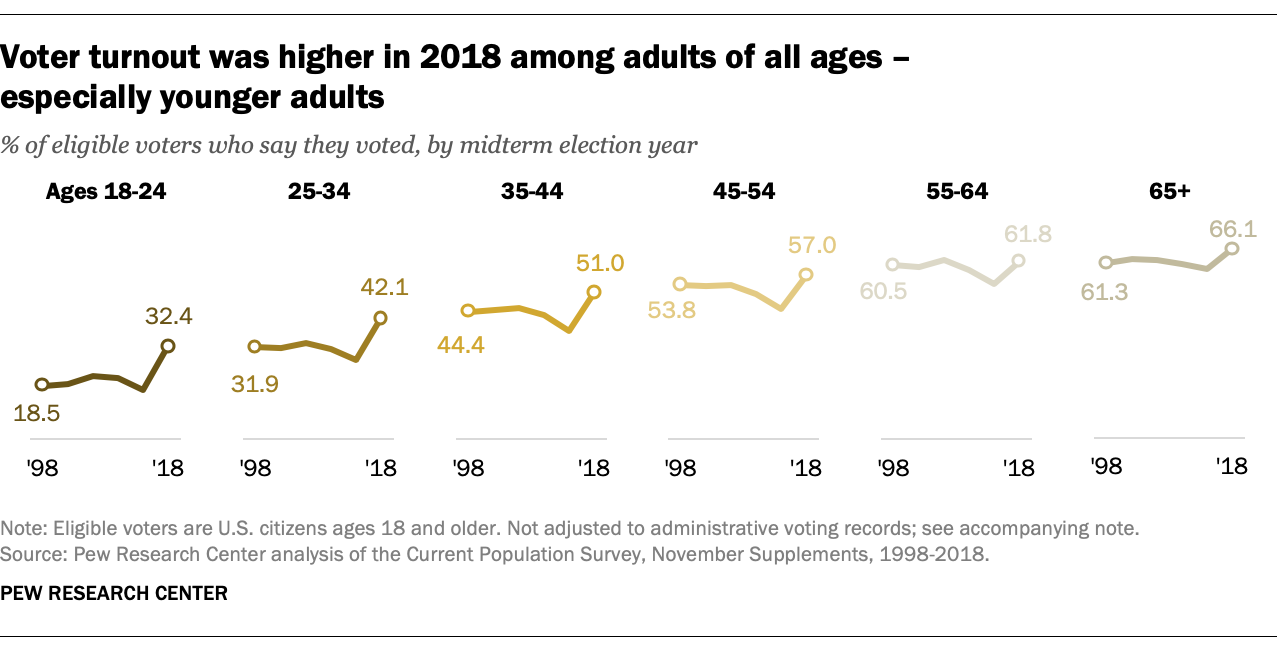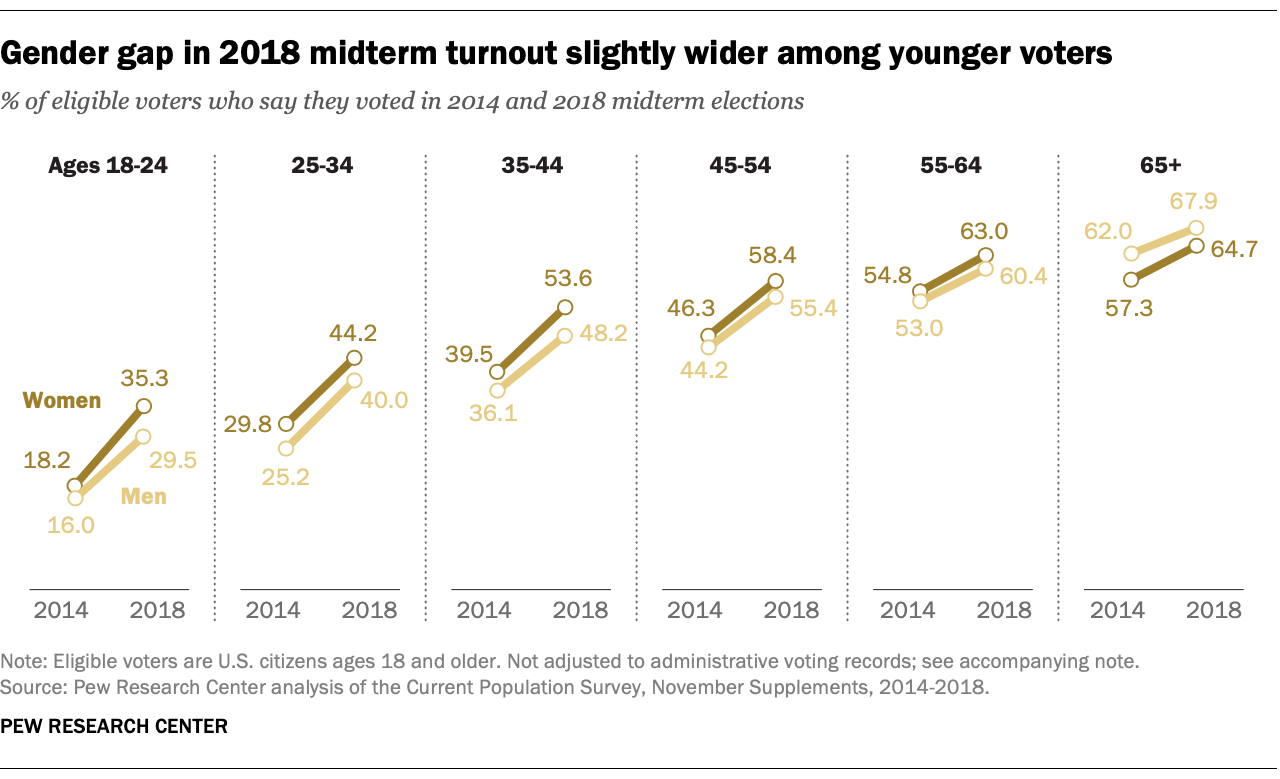 Voters
in Henderson, Nevada, on Election Day 2018. More than half of women who
were eligible to vote cast ballots in the midterms. (Ethan Miller/Getty
Images)
Voters
in Henderson, Nevada, on Election Day 2018. More than half of women who
were eligible to vote cast ballots in the midterms. (Ethan Miller/Getty
Images)
Both men and women turned out at record rates in the 2018 midterm election – mirroring historic turnout increases among other segments of the eligible voting population. Compared with 2014, voter turnout increased by double digits among both men (11 percentage points) and women (12 points).
 As
has been the case in the last five midterm elections dating back to
1998, women turned out to vote at slightly higher rates than men. Over
half of women (55%) who were eligible to vote cast ballots in the 2018
midterms in November, as did 51.8% of men, according to a Pew Research
Center analysis of newly released data from the U.S. Census Bureau.
As
has been the case in the last five midterm elections dating back to
1998, women turned out to vote at slightly higher rates than men. Over
half of women (55%) who were eligible to vote cast ballots in the 2018
midterms in November, as did 51.8% of men, according to a Pew Research
Center analysis of newly released data from the U.S. Census Bureau. The 3.2 percentage point gender gap in turnout is similar to the gap in the 2014 (2.2 points), and slightly bigger than the gap in 2010 (less than 1 point).
In 2018, women made up about the same share of the electorate as they did in the previous five midterms; 53% of voters were women and 47% were men.
Voter turnout was higher among adults of all ages in 2018 relative to 2014 – but increased the most among younger voters. Between 2014 and 2018, turnout among adults under 25 nearly doubled – from 17.1% to 32.4%. Turnout among adults ages 25 to 34 rose by more than 14 percentage points (27.6% to 42.1%) and more than 13 points among those 35 to 44 (37.8% to 51%).
 The
increases in turnout among older adults were more modest. About
two-thirds (66.1%) of eligible adults 65 and older cast a ballot in the
2018 midterm – up from 59.4% in the 2014 midterm election. Those ages 55
to 64 increased their turnout rate by 7.8 percentage points. Older age
groups continued to be much more likely than younger groups to vote in
the midterms.
The
increases in turnout among older adults were more modest. About
two-thirds (66.1%) of eligible adults 65 and older cast a ballot in the
2018 midterm – up from 59.4% in the 2014 midterm election. Those ages 55
to 64 increased their turnout rate by 7.8 percentage points. Older age
groups continued to be much more likely than younger groups to vote in
the midterms. Challenges in estimating voter turnout rates with the Current Population Survey
The electorate was younger in 2018 than in 2014 as a result of relatively high turnout among young adults. In 2014, 16% of the electorate was under 35. In 2018, these voters made up 21% of the electorate.
Though turnout among women was about 3 percentage points higher than men overall, the difference in turnout by gender varied significantly by age. Among younger voters (18 to 44), the gender gap was wider than the gap for older voters (45 and older).
The gender gap in turnout among the youngest group of voters was also larger than it was in 2014. Five years ago, slightly more women ages 18 to 24 turned out in the midterm election than men (18.2% and 16%, respectively). The 2.2 percentage point gap in 2014 was similar to that of 2010 and 2006. But last year, the gender gap in turnout was significantly larger; 35.3% of women 18 to 24 turned out, compared with 29.5% of men.
 As
in 2014, the only age group where turnout was higher for men than women
was among adults ages 65 and older (67.9% vs. 64.7%).
As
in 2014, the only age group where turnout was higher for men than women
was among adults ages 65 and older (67.9% vs. 64.7%). Correction: In a previous version of this post, Aram Hur’s name was misspelled in the section “Challenges in estimating voter turnout rates with the Current Population Survey.”

אין תגובות:
הוסף רשומת תגובה